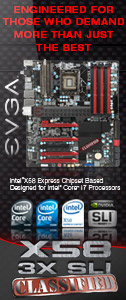« Previous Page | 1 2 3 4 - View All | Next Page »
Test Kit
Hardware
- Asus Sabertooth 55i motherboard
- Intel i3 530 retail processor clocked at 3.6ghz (18×200)
- Nvidia 8800gtx
- Western Digital 500GB SATA-II hard drive
- Generic DVDRW SATA unit
- OCZ Stealth Stream 400W PSU
- G.Skill RipJaw 2000mhz 1.6v (2×2gb) cl9
- G.Skill RipJaw 1600mhz 1.5-1.65v (2×2gb) cl8
- G.Skill ECO 1600mhz 1.35v (2×2gb) cl8
Software
- Windows Vista Home Premium 64bit
- Intel system drivers
- Forceware 195.62 for vista/win7 64bit
Testing Software
- Sisoftware Sandra 2009
- Everest
- WinRar Compression Utility
- cpu-z
Testing
As you may all be aware memory pricing varies across the board from manufacturer to manufacturer. Kits with low timings and higher frequencies are generally considerably more costly than kits that ship with more modest frequencies and less tight timings. The G.Skill ECO series of memory kits fall straight in the middle of the ddr3 range sporting an average latency set of 8-8-8-24 and speeds of 1600MHZ; So why the big fuss? Why is this kit so special? The answer to that falls down to one very simple little requirement, the operational voltage. At just 1.35vOLTS the ECO range of i3/i5/i7 memory kits fall in most cases a full 0.3vOLTS shy of the competition. With this reduction in voltage comes a reduction in power consumption and heat but the main reason they are so special and have generated so much interest falls to the potential that these modules may have with a little TLC and overclocking know how.
For comparison purposes a 1.65volt rated 1600MHZ G.Skill RipJaw kit has been selected as it sports identical timings and frequency to the ECO kit on test. A set of G.Skill RipJaw 2000mhz cl9 modules has also been selected.
Everest
As you can see from the graph above the G.Skill ECO performs on a level that is near identical to the 1600MHZ RipJaw kit. You will see this very same trend across the review as voltage plays no part in how fast the memory performs. There are of course slight variations between the results but due to how small the margins are we can safely deduce that this is due to fluctuations in idle tasks etc within the operating system rather than any tangible benefit from one kit to the other. The 2000MHZ RipJaw kit as expected with its higher frequencies has proven to be a superior kit and shows that the latency increase to cl9 from cl8 on the other two kits has had little effect. Latency has also reduced with speed but not to a level that would make any difference in real world usage.
Sisoft Sandra Lite 2010c
Once again we can see that the difference between the ECO kit and the 1600MHZ RipJaw is minimal and once again will be down to fluctuations within the operating system! Like all synthetic benchmarks there is a difference is the results in this case showing a slight increase in bandwidth from all kits. Where as bandwidth has increased for the better the latency has taken a slight turn for the worse and has increased. Again this is nothing that could be noticed by the consumert
WinRar File Compression and Encryption
You may be wondering why this test has been added to the review? The reason for this is to see what benefit if any you would see from having a faster kit in your home computer. As you can see in the graph above frequency does indeed have its uses. The ECO kit once again faired well against the 1600MHZ RipJaws showing that there really is hardly any difference between different kits provided the frequency and timings remain the same. The extra speed the 2000MHZ kit has on tap is once again evident shaving a few seconds off of each scenario. This in its self is conclusive evidence that buying faster memory has its benefits in real world usage. Whether or not the price increase you may face for these extra seconds saved is worth it though is another question.









